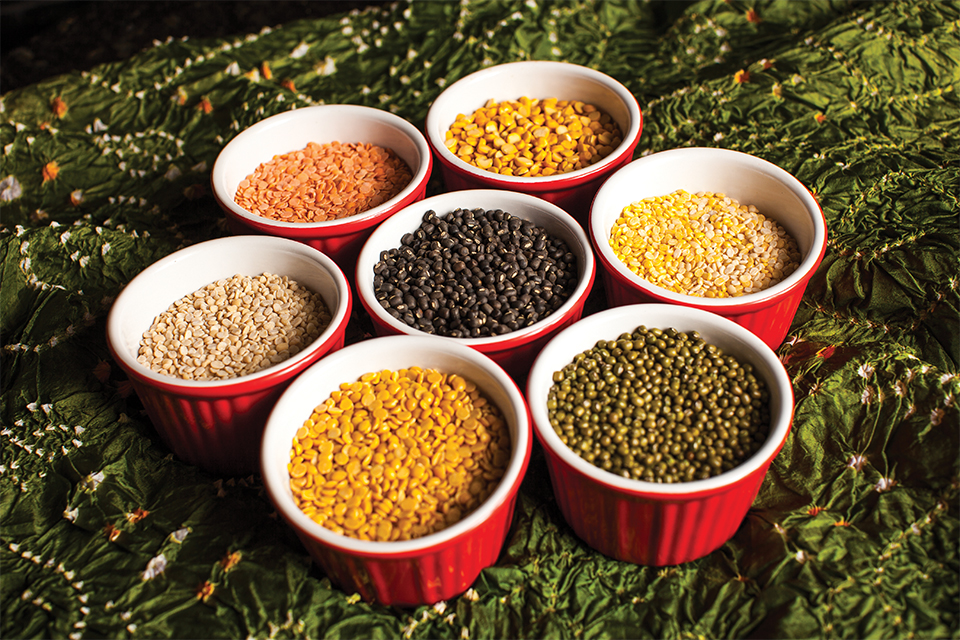Quick and Healthy Lentils—That’s Dal!

What is your requirement for a quick, healthy, weeknight dinner? If fresh, healthy, and fast sounds too perfect a requirement for any dinner, then you may not know the magic of lentils. Lentils aren’t quite as wondrous as the beans in “Jack and the Beanstalk,” but they do provide the gifts of good health and a fast, delicious dinner.
Lentils are full of beneficial nutrients (high fiber, protein, minerals, and vitamins) yet provide low-fat calories. Dal are whole beans or legumes that are often peeled and split. The word dal is derived from the Sanskrit verbal root word meaning “to split.” Dal also refers to an Indian puree/soup/curry that is made from these lentils.
Lentils come in a variety of types, colors, and sizes, each with a distinctive flavor, and all can be made into amazing recipes. They can act as a base for soups, stews, salads, burgers, casseroles, pilafs, appetizers, side dishes, and main entrees and, in addition to being an important staple in Indian cooking, they are part of Mediterranean, Mexican, French, and American cuisines.
Look for lentils in most grocery stores. Specific varieties can be found in Indian, Mexican, and Middle Eastern groceries or at Whole Foods Market and Trader Joe’s. Of all the kinds available, lentils that have been split and had their hulls removed contain less fiber but cook faster than whole lentils or beans. Of the various types, red lentils cook the fastest.
It’s time to add lentils to the pantry and prepare some fresh, healthy, and delicious dinners fast.
3 Benefits of Eating Lentils
High Protein – More than 25 percent of the calories in lentils are protein; they are considered one of the best sources of protein for vegans and vegetarians.
Low Fat – Unlike meat, lentils provide protein without fat calories; 1 cup of lentils contains only 1 gram of fat and about 230 calories, making them popular with people who are diet- and calorie-conscious or on a weight-loss program.
Beneficial Nutrients – Lentils contain complex carbohydrates, resistant starch, protein, and fiber, which provide slow-burning energy and increases metabolism. They are also high in soluble fiber, (reduces cholesterol) and triglycerides (lowers blood sugar), and the dietary fiber in lentils helps with stomach and digestive issues, such as constipation and irritable bowel syndrome. Lentils are a good source of iron, folate (vitamin B), and magnesium, and other nutrients like manganese, phosphorous, zinc, copper, and potassium. Iron helps in prevention of anemia. Folic acid aids in cell growth and helps in preventing fractures, osteoporosis, arthritis, inflammations, and repair and growth of the body. It’s an essential nutrient for women, especially pregnant women. Magnesium helps relax the smooth muscles and reduces cramps, stiffness, and stress in the body; it can even uplift moods.
Types of Lentils
Each cuisine adopts its own variety for recipes. But lentils are versatile; it’s easy to interchange types to make the same recipe differently, and they can also be used as a low-glycemic grain substitute.
Black whole beans make the ivory white lentil (urad dal) when split and husked. When boiled and cooked, they are firmer, and so black or white dal is a great side dish or salad. In Indian cuisine, white lentil flour is used to make lentil crepes (dosa), rice and lentil steamed cakes (idlis), and lentil fritters (vadas).
There are many kinds of yellow lentils. Indian pigeon peas are split to medium yellow lentils (tuar dal), and black chickpeas split to large yellow lentils (chana dal). Both are great in quick soups and stews. The large yellow lentils are good in pilafs, casseroles, and stuffing; the flour can make flat breads, dumplings, falafels, and fritters.
There are many kinds of brown/olive green lentils: German, Indian, Spanish, continental, and more. Brown lentils cook to a mushy consistency, making them great for soups, stew, lentil burgers, and Sloppy Joes.
The small dark green French lentil (puy lentils or lentilles vertes du Puy) are perfect for salads, as they are tougher and remain firm after cooking.
Red lentils are very mushy when cooked—great for stews and soups, like tadka dal.
When split and husked, green whole mung beans are small yellow split lentil (mung dal). Green mung is very nutritious and popularly used in salads. The split mung cooks very quickly, and is good in soups, stews, pilafs, and lentil-rice casseroles.
Mexican macachiados, which take longer to cook, are large yellow lentils used in chilis and stews.






